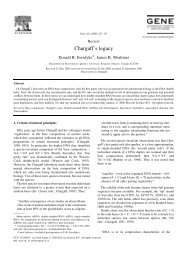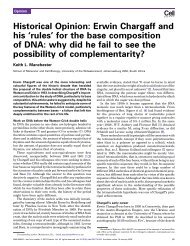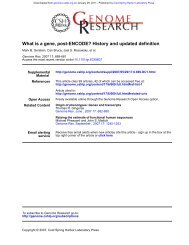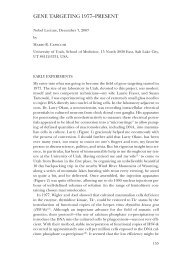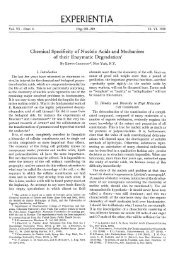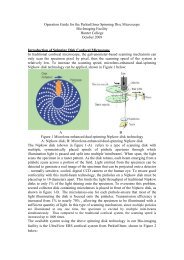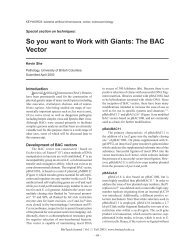Cold Spring Harb Symp Quant Biol-1953-Watson-SQB ... - Biology
Cold Spring Harb Symp Quant Biol-1953-Watson-SQB ... - Biology
Cold Spring Harb Symp Quant Biol-1953-Watson-SQB ... - Biology
You also want an ePaper? Increase the reach of your titles
YUMPU automatically turns print PDFs into web optimized ePapers that Google loves.
Downloaded from symposium.cshlp.org on March 26, 2009 - Published by <strong>Cold</strong> <strong>Spring</strong> <strong>Harb</strong>or Laboratory Press<br />
124 ]. D. WATSON AND F. H. C. CRICK<br />
bone. Recently these indirect inferences have been<br />
confirmed by electron microscopy. Employing high<br />
resolution techniques both Williams (1952) and<br />
Kahler et al. (<strong>1953</strong>) have observed, in preparations<br />
of DNA, very long thin fibers with a uniform width<br />
of approximately 15-20 A.<br />
II. EVIDENCE FOR THE EXISTENCE OF TWO C~E~I-<br />
CAL CHAINS IN THE FIBER<br />
This evidence comes mainly from X-ray studies.<br />
The material used is the sodium salt of DNA (usually<br />
from calf thymus) which has been extracted,<br />
purified, and drawn into fibers. These fibers are<br />
highly birefringent, show marked ultraviolet and<br />
infrared dichroism (Wilkins et al., 1951; Fraser<br />
and Fraser, 1951), and give good X-ray fiber diagrams.<br />
From a preliminary study of these, Wilkins,<br />
Franklin and their co-workers at King's College,<br />
London (Wilkins et al., <strong>1953</strong>; Franklin and<br />
Gosling <strong>1953</strong>a, b and c) have been able to draw<br />
certain general conclusions about the structure of<br />
DNA. Two important facts emerge from their<br />
work. They are:<br />
(1) Two distinct ]orms of DNA exist. Firstly a<br />
crystalline form, Structure A, (Figure 2) which<br />
occurs at about 75 per cent relative humidity and<br />
contains approximately 30 per cent water. At higher<br />
humidities the fibers take up more water, increase<br />
in length by about 30 per cent and assume<br />
Structure B (Figure 3). This is a less ordered<br />
form than Structure A, and appears to be paracrystalline;<br />
that is, the individual molecules are all<br />
packed parallel to one another, but are not otherwise<br />
regularly arranged in space. In Table 1, we<br />
have tabulated some of the characteristic features<br />
which distinguish the two forms. The transition<br />
from A to B is reversible and therefore the two<br />
.structures are likely to be related in a simple<br />
manner.<br />
(2) The crystallographic unit contains two polynucleotide<br />
chains. The argument is crystallographic<br />
and so will only be given in outline. Structure B<br />
has a very strong 3.4 A reflexion on the meridian.<br />
As first pointed out by Astbury (1947), this can<br />
only mean that the nucleotides in it occur in groups<br />
spaced 3.4 A apart in the fiber direction. On going<br />
from Structure B to Structure A the fiber shortens<br />
by about 30 per cent. Thus in Structure A the<br />
~roups must he about 2.5 per cent A apart axially.<br />
The measured density of Structure A, (Franklin<br />
FIGURE 2. X-ray fiber diagram of Structure A of desoxyribonucleic<br />
acid. (H. M. F. Wilkins and H. R. Wilson,<br />
unpub.)<br />
and Gosling, <strong>1953</strong>c) together with the cell dimensions,<br />
shows that there must be two nucleotides in<br />
each such group. Thus it is very probable that the<br />
crystallographic unit consists of two distinct polynucleotide<br />
chains. Final proof of this can only<br />
come from a complete solution of the structure.<br />
Structure A has a pseudo-hexagonal lattice, in<br />
which the lattice points are 22 A apart. This distance<br />
roughly corresponds With the diameter of<br />
fibers seen in the electron microscope, bearing in<br />
mind that the latter are quite dry. Thus it is probable<br />
that the crystallographic unit and the fiber<br />
are the one and the same.<br />
III. DESCRIPTION OF THE PROPOSED STRUCTURE<br />
Two conclusions might profitably he drawn from<br />
the above data. Firstly, the structure of DNA is<br />
TABLE 1.<br />
(From Franklin and Gosling, <strong>1953</strong>a, b and e)<br />
Number of<br />
Location of<br />
nucleotides<br />
Degree of Repeat distance first equatorial Water within unit<br />
orientation along fiber axis spacing content cell<br />
Structure A Crystalline 28 A 18 A 30% 22-24<br />
Structure B Paraerystalline 34 A 22-24 A > 30% 20 (?)



